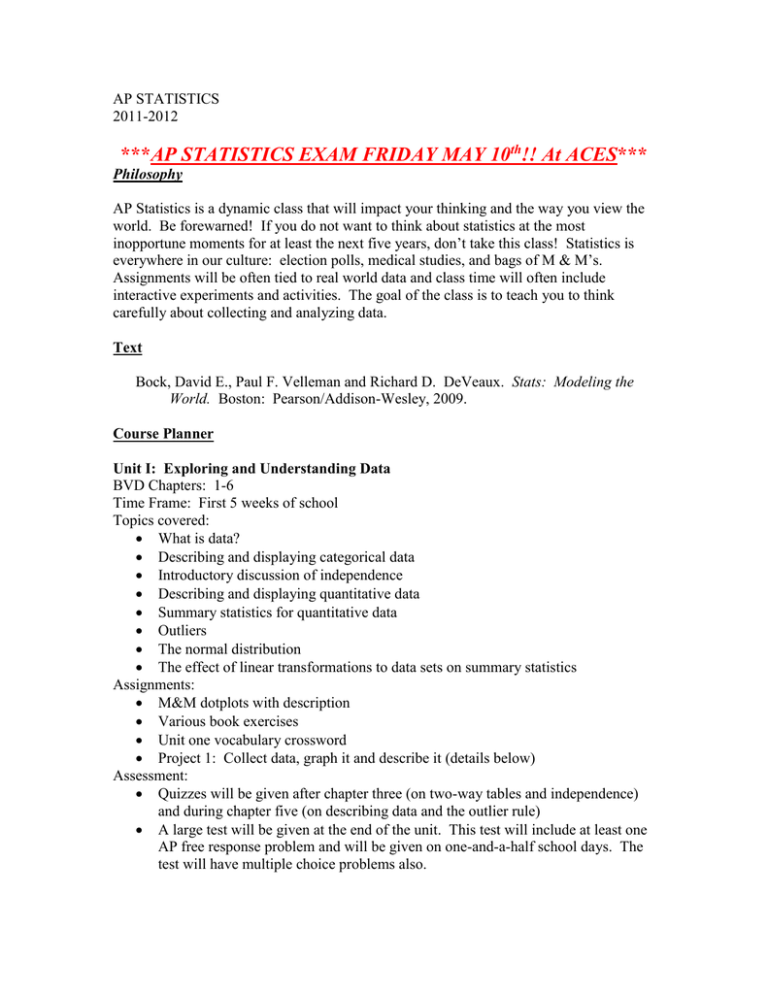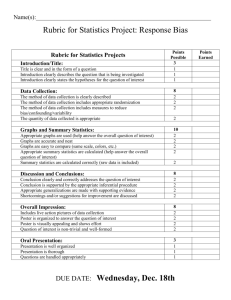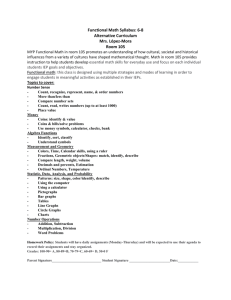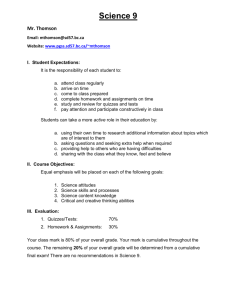
AP STATISTICS
2011-2012
***AP STATISTICS EXAM FRIDAY MAY 10th!! At ACES***
Philosophy
AP Statistics is a dynamic class that will impact your thinking and the way you view the
world. Be forewarned! If you do not want to think about statistics at the most
inopportune moments for at least the next five years, don’t take this class! Statistics is
everywhere in our culture: election polls, medical studies, and bags of M & M’s.
Assignments will be often tied to real world data and class time will often include
interactive experiments and activities. The goal of the class is to teach you to think
carefully about collecting and analyzing data.
Text
Bock, David E., Paul F. Velleman and Richard D. DeVeaux. Stats: Modeling the
World. Boston: Pearson/Addison-Wesley, 2009.
Course Planner
Unit I: Exploring and Understanding Data
BVD Chapters: 1-6
Time Frame: First 5 weeks of school
Topics covered:
What is data?
Describing and displaying categorical data
Introductory discussion of independence
Describing and displaying quantitative data
Summary statistics for quantitative data
Outliers
The normal distribution
The effect of linear transformations to data sets on summary statistics
Assignments:
M&M dotplots with description
Various book exercises
Unit one vocabulary crossword
Project 1: Collect data, graph it and describe it (details below)
Assessment:
Quizzes will be given after chapter three (on two-way tables and independence)
and during chapter five (on describing data and the outlier rule)
A large test will be given at the end of the unit. This test will include at least one
AP free response problem and will be given on one-and-a-half school days. The
test will have multiple choice problems also.
Unit II: Regression
BVD Chapters: 7-10
Time Frame: Weeks 6-9
Topics covered:
Displaying and describing scatterplots
Analyzing two-variable quantitative data:
o Correlation and the coefficient of determination
o Least-squares regression
o Slope and y-intercept
o Residuals and residual plots
o Outliers and influential points
Transformations to achieve linearity
Assignments:
Various book exercises
Unit two vocabulary crossword
Assessment:
A quiz will be given on describing scatterplots after chapter seven and another
quiz during chapter eight on regression.
There will be two tests in this unit. The first test will cover chapters seven and
eight. Then another test will be given at the end of the unit that will be
cumulative over the entire unit. Chapter six (normal questions) will also be
included on the tests. Tests will include multiple choice and free response
questions.
Unit III: Collecting Data
BVD Chapters: 12-13
Time Frame: Weeks 10-13
Topics covered:
Designing surveys via various methods
Bias in surveys
Randomization and representative samples
Experimental design:
o Control
o Random assignment of treatment
o Replication
o Placebo & blinding
o Blocking and matched pairs
o Confounding and lurking variables
o Statistically significant difference (introduction)
Observational studies
Assignments:
Various book exercises
Unit three vocabulary crossword
Project Two: Bias project (details below)
Assessment:
In addition to 10 multiple choice, your test will be three AP-like free response
questions.
Unit IV: Probability
BVD Chapters: 11, 14-18
Time Frame: Weeks 14-18, and the first 2 weeks of second semester
Topics covered:
Basic probability principles including complement, independence and mutually
exclusive
Simulating probability scenarios
Addition, multiplication and conditional probability rules
Random variables:
o Expected value and standard deviation
o Rules for transforming and combining random variables
Binomial and geometric distributions
Sampling distributions for means and proportions
Assignments:
Various book exercises
Unit four vocabulary crossword
Examination of homemade dice data—law of large numbers
Assessment:
There will be a few short probability quizzes
This unit will straddle a busy time of year. Testing will be as follows:
o A big test before the Holiday Break (chapters 14-16)
o Chapter 11 in January. Cumulative semester final in January covering
everything through chapter 16.
o Chapters 17 and 18 will be covered in the first two weeks of second
semester with a short test immediately following.
Unit V: Inference for Proportions
BVD Chapters: 19-22
Time Frame: Weeks 3-6
Topics covered:
Confidence intervals for one and two proportions
Hypothesis testing for one and two proportions
Type I and II errors and power
Assignments:
Various book exercises
Unit five vocabulary crossword
Assessment:
A quiz will be given on confidence intervals after chapter 19.
A test will be given at the end of chapter 20. Another test will be given after 21
and again after 22. Sampling distribution questions will be included on at least
one exam.
Unit VI: Inference for Means
BVD Chapters: 23-25
Time Frame: Weeks 7-9
Topics covered:
Confidence intervals for one and two means (with t)
Hypothesis testing for one and two means (with t)
Confidence intervals and hypothesis testing for matched pairs means (with t)
Assignments:
Various book exercises
Unit six vocabulary crossword
Assessment:
A quiz on 1-sample t-procedures will be given after chapter 23.
A test will be given at the end of the unit.
Unit VII: Inference for Counts and Slope
BVD Chapters: 26-27
Time Frame: Weeks 10-11
Topics covered:
Chi-square goodness-of-fit
Chi-square for homogeneity and for independence
Confidence interval for slope
Hypothesis testing for slope
Assignments:
Various book exercises
Unit seven vocabulary crossword
Assessment:
A test will be given at the end of the unit. This test will include questions from
Unit II (regression).
Review for the Exam
Time Frame: Weeks 11-14
Assignments:
Various book exercises
Practice Free Response problems will be used extensively
Practice work from a review book will also be assigned
Assessment:
As we review the course, free response questions will be given as quizzes. Your
free response scores will be accumulated to make a practice test score.
A practice multiple choice exam will be given.
Cumulative Project
Time Frame: Weeks 15-18
Assignments:
Cumulative year-end project (details below)
Assessment:
Your final project will graded according to a rubric to be shared at a later date.
Student Activities
Project 1
Exploring Data
Page 1
1st paragraph:
How and where you collected your data (collect at least 25 data
points, data must be quantitative)
2nd paragraph:
Do you think your data represents the population you were
studying? Why or why not? What sources of bias do you think
may have been present in your data collection?
3rd paragraph:
By studying graphs of the data, what relationships can be
observed? What do the graphs show? What conclusions can be
drawn?
Page 1 must be typed.
Page 2 +
Graph your data.
By hand, neatly, is fine
Make TWO different types of graphs for the quantitative data—histogram,
boxplot, stemplot and/or dotplot
Excel?—Makes great pie graphs and lousy histograms—proceed at thy own peril…
Main Ideas: to practice describing data and graphs and to BEGIN to think about data
collection and sources of bias.
Statistics Project: Bias in Surveys
The Purpose: To investigate how much different forms of bias can affect the results of a
survey.
The Project:
*The project must be done in groups of one to four. You will turn in one
poster/powerpoint per group.
*A brief oral presentation and poster/powerpoint will be required for each group. NO
REPORT NEEDED!
Due Dates:
*Proposal: Wednesday, November 16th
*Poster: On your presentation date, between December 5th and December 16th.
Your group will be randomly assigned a presentation date. If your group is not ready
and/or does not have 100% attendance on that date, you will be moved to a different date
and receive a 20% penalty on your presentation grade.
Topic: You will design a survey on an interesting topic of your choice, but you must
design it so you can address ONE of the following questions:
Is it possible to word a question in two different ways that are logically
equivalent, but have much different responses?
Do the characteristics of the interviewer affect responses?
Does anonymity change the responses to sensitive questions?
Does providing extra information affect the responses?
NOTE: You may choose another form of bias if you get special approval from the
teacher.
You should compare at least 2 different groups. Usually this is a “control” question
that is “normal” and unbiased and then a second group that is biased in a certain
direction. Depending on your idea, you may choose to have 2 different biases—one
that will tilt in one direction and one that will tilt in another direction. You will not
be penalized if you do not succeed in creating a large bias.
Proposal:
1. -A definition of the population.
2. -A copy of your survey questions.
3. –A short description of how you will create bias and what direction you think the
bias will swing.
4. -Where and how you will collect your data.
NOTE: Your sampling procedure should not be biased. Survey 50 people per question
(50 unbiased, 50 for each bias)
Poster: The poster should be completely summarize your project, yet be simple
enough to be understood by a freshman. Remember the purpose of the project! It should
be pleasing to the eye. It should include a one-page typed paper describing what you did.
The colors on your graphs are crucial to communicating your bias: use a consistent
color-key so the change can be easily spotted.
Points: 30 points: 10 for appearance, 10 for clear communication on graphs, 10 for
report
Oral Presentation: All group members need to participate equally. Your poster should
be used as a visual aid. 5 minutes. To receive full credit for your presentation your
group must speak clearly, with confidence and must do something to ENGAGE THE
AUDIENCE. I leave it open-ended as to exactly what you tell us about what you did, but
I absolutely insist that your presentation be clear, interesting and well-spoken (if you
want full credit!). We do not have time for elaborate props/media set-up. Your task is to
be engaging with your mouths, not by bringing in multi-media.
Points: 20 points: 10 for being engaging, 10 points for clear communication
END OF THE YEAR CUMULATIVE PROJECT (five parts):
Report Proposal
Due Tuesday, April 3th
The question of investigation/curiosity:
Population of interest:
A brief description of how and where you are going to collect your data:
Difficulty/Interest Rating: ______ (to be completed by ME!)
I. Data Report (20 points)
Due Thursday April 19th
This section should be a thorough explanation of how you collected your data and be a
beautiful example of how much you’ve learned this year about the difficulties getting a
representative sample. Examples of what you should include are:
How you collected your data
Why you are confident your sample matches your population
Biases avoided and not avoided
A copy of any survey that was filled out
Your data: either in “Excel” format or in a table/matrix summary. You need at
least 75 people/subjects for each group you want to compare. Your data should
be broken up by any category you want to compare.
II. Exploring the Data (25 points)
Due Wednesday April 31st
This section should be an outstanding example of exploratory data analysis (the
first unit in our text). Graphs should show the comparisons between all relevant
groups you are comparing. You should state any preliminary conclusions that can
be drawn by using your eyeballs.
Graphs of your data
Statistics from your data
Descriptions of the graphs and statistics.
III. Analyzing the Data (25 points)
Due Wednesday May 9th
Analyze your data using whatever method(s) is appropriate for your data. Your
conclusion should be nicely written using all appropriate statistical support. Remember
that confidence intervals can be a powerful method for comparing different groups.
Hypothesis Test (with conditions checked) and/or
Confidence Intervals (with conditions checked) and/or
Regression
Your Grand Conclusion!
Extra Credit for DataDesk
IV. Presentation (20 points)
Due by Friday, May 11th
Must include:
Clearly communicate your question and how you collected your data (5 pts.).
Visually display graphs of your data—PowerPoint (if you must), overhead,
poster, or video (5 pts.). I do not want a pretty poster that summarizes your
whole project. I want you to make a visual aid that shows the class how your data
came out. There should be only minimal text on your visual aid—titles and big
numbers—not any explanations.
Clearly communicate your conclusion (5 pts.).
Be interesting to listen to and give us some sort of “hook” to inspire us to listen (5
pts).
Do not read off your visual aid—use note cards or your report. Be careful how
you communicate numbers to the class—too many numbers at once is confusing,
as is too many decimal places.
V. Success!? (15 points)
I will evaluate the overall success and difficulty of your project. More challenging data
collection issues add to your score. Small sample sizes or an overly simple question will
lower your score.
Details You Should Know
Make your own copies of the data, etc. Once you turn in one part of your report, I
need to keep it.
Don’t get lazy—this is to be the summation of what you’ve learned all year.
Please type your paper. Hand-done work is acceptable for some graphs, etc if it is
done very neatly.
Your work should be thorough and nicely written. Bullet points can be used to
delineate a list of observations. Clear communication and thorough analysis is
necessary for full credit.
Instructor reserves the right to modify/add/delete this syllabus as
needed throughout the year!
Materials Needed for Every Class:
Notebook & Folder or Binder
Pencil/Pen (PENCIL is preferred)
Calculator – this will be supplied for you to borrow during class
Classroom Rules
1.
2.
Respect: Treat yourself and others with respect.
Responsible: Be in assigned seat with books and materials,
ready to work when the bell rings
3.
Represent the “N”: Return all classroom materials and tidy up area
each day before leaving classroom
If you CHOOSE to break a rule
st
o 1 time – Verbal warning
o 2nd time – Conference with student
o 3rd time – 15 minute Teacher DT
o 4th time – Call to parent
o 5th time – Referral to administrator
Consequences are cumulative!!!!
**Any serious violation will result in immediate referral.**
***Truly wonderful/consistent behavior will result in positive phone call/email
home!!!!***
Classroom Procedures:
Student will be given 2 “Out of Room” passes per quarter. If student should have
to leave the room for any personal reason (restroom, locker, etc.) then a pass will
be given to the teacher. Passes not used can be returned to the teacher for Extra
Credit for that quarter. Students will not be permitted to leave class without a
pass.
No late work will be accepted! Homework is typically due the next day and
always at the beginning of class. There is a basket on my desk to place
homework in.
o Unexcused absences – you will not be allowed to make up anything from
that day.
o Excused absences – per school policy, you have 3 days for every 1 day of
excused absence. You must see me before or after school the first day you
return to get your work or set up a time for help.
o Field Trips/Gear-Up/College Visits etc – all school functions that cause
you to miss class time are planned and you know about them before hand.
Therefore, you must get your assignment before you go on your trip. Class
will continue as usual during field trips. All work that you miss is due the
first day you return to class! Work turned in after this will not be accepted.
Math School Fees
o If you are assigned a calculator, or you check one out to borrow, and it is
not returned or is returned broken you will be charged an $80.00 school
fee to replace it.
o All school fees must be paid in full in order to attend Prom or to pick up
your Diploma.





